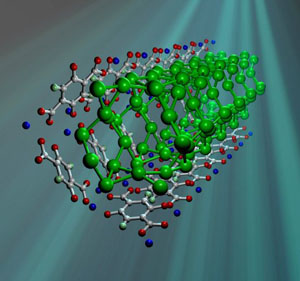Using renewable energy sources, such as wind, solar, and tidal, to convert biomass into hydrogen fuel, could underpin a future hydrogen economy based on fuel cell devices that then convert the hydrogen into water and release the pent up energy. However, storing useful volumes of hydrogen for powering fuel cell vehicles remains a major obstacle hindering efforts. Now, US scientists believe they may be one step closer to understanding how to build a fuel tank for a clean, efficient, hydrogen-powered car.
Researchers at the National Institute of Standards and Technology’s Center for Neutron Research (NCNR) have investigated a type of highly porous material developed at the University of California Los Angeles. The material could act like a sponge to soak up and trap huge volumes of hydrogen gas without the need for vastly raised pressures or temperatures.

Hydrogen straw (Credit: NIST)
NCNR’s Craig Brown and colleagues at the University of Maryland and the California Institute of Technology have studied a range of metal-organic frameworks (MOFs). These highly porous materials can absorb gases when pressure is applied and then release them again when they are heated. Brown and colleagues believe that such materials could be engineered so that refuelling becomes as easy as pumping petrol is today.
One particular material, MOF-74, based on a carbon skeleton interspersed with zinc atoms exists as a porous, crystalline powder. At the molecular level, MOF-74 resembles a series of tightly packed straws. It is so porous that just one gram of the material has an internal surface area equivalent to two basketball courts.
The researchers used neutron scattering and gas adsorption techniques to determine that at 77 K (-196 Celsius), MOF-74 can adsorb more hydrogen than any other unpressurized framework structure known. The density of the absorbed hydrogen is even higher than it would be if the gas were frozen into a solid block. Brown admits that the team does not yet understand what allows hydrogen to be packed in so tightly, but the zinc centres seem to be key to the process.
When we started doing experiments, we realized the metal interaction doesn’t just increase the temperature at which hydrogen can be stored, but it also increases the density above that in solid hydrogen, Brown says. This is absolutely the first time this has been encountered without having to use pressure. Although the liquid-nitrogen temperature of MOF-74 is not exactly temperate, it’s easier to reach than the temperature of solid hydrogen (-269 C), and one of the goals of this research is to achieve energy densities great enough to be as economical as petrol at ambient, and so cheaper temperatures. MOF-74 is a step forward in those terms.
Further reading
Langmuir, 2008, in press
http://dx.doi.org/10.1021/la703864a
Suggested searches
renewable energy
fuel cells
hydrogen fuel